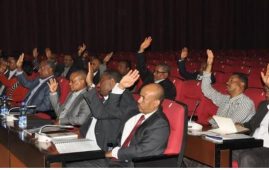Phil Clark, an academician specializing on African issues, published an interesting piece on ‘Why has the Arab Spring so far failed to spread south of the Sahara – and should some African leaders be looking over their shoulders?’.
He begins with the premise that ‘all of the principal causes of revolution in north Africa also pertained south of the Sahara’. Then, he hypothesizes ‘three principal reasons’ for the absence of Northern African styled revolution in Sub-Saharan Africa.
While Mr. Clark’s piece is an interesting addition to the discussion, the apparent lack of sufficient data or haste crippled his analyses. Not to mention, his erroneous claim that there was ‘political and economic protests broke out’ in Ethiopia and Kenya in the first half of 2011, which casts doubt on the depth of his analyses.
Read Phil Clark’s piece below:
***************
Arab Spring south of the Sahara?
When the ‘Jasmine Revolution’ rolled eastward from Tunisia to Libya and Egypt in early 2011, many commentators – not to mention many jittery African leaders – believed that a southward spread was inevitable. All of the principal causes of revolution in north Africa also pertained south of the Sahara: decades-long dictatorships, endemic government corruption, enormous wealth disparities, high unemployment, public fury over rigged elections, rising commodity prices and a lack of civil and political rights. Indeed, the contagion of revolution seemed to have taken hold when political and economic protests broke out across Africa in the first half of 2011, with protestors in Sudan, Uganda, Kenya, Rwanda, Ethiopia, Morocco, Senegal, Burkina Faso, Nigeria, Gabon and South Africa citing the ‘north African spring’ as their inspiration.
Ultimately, though, these protests were forcibly quashed or fizzled out – which points to key differences in the nature of politics and society between north and sub-Saharan Africa. Nevertheless, the vestiges of the 2011 protests will continue to cause sleepless nights for many African leaders.
There are three principal reasons – some immediate and some more deeply embedded – why the north African spring so far hasn’t spread to the rest of the Africa.
First, the protestors’ success in north Africa meant that the element of surprise was lost. Sub-Saharan governments, panicked by the toppling of the north African dictators, responded immediately by violently quelling dissent or making strategic political and economic concessions in an attempt to nip domestic protests in the bud. At the first signs of unrest, the Ugandan, Ethiopian, Nigerian and Senegalese governments put the military on the streets, cordoned off key public spaces, and arrested opposition politicians, journalists and civil society actors.
During February 2011 elections, the Ugandan government – concerned that a tech-savvy population could generate another Tahrir Square – shut down Facebook and Twitter, attacked opposition leaders and their supporters and prohibited the instant-messaging of words such as ‘Mubarak’, ‘Ben Ali’, ‘people power’, ‘bullet’, ‘police’ and ‘teargas’. All of this happened under the watchful eye of the International Criminal Court (ICC), which has been investigating serious crimes in Uganda since 2004, raising doubts over claims by the ICC’s backers that the court helps to deter atrocities. Because the Ugandan government is a key ally of the ICC in its pursuit of Joseph Kony and other leaders of the Lord’s Resistance Army, the ICC has so far shown no willingness to deal with crimes committed by government forces.
While some African governments cracked down to stifle revolution, others offered the protestors important concessions. Morocco instituted major political reforms, including constitutional changes that diminished the power of the monarchy; Burkina Faso created a consultative council to address protestors’ concerns over elite entrenchment of political and economic power; and Rwanda and Kenya issued fuel subsidies to alleviate economic pressures on the population. These measures had a dampening effect on the protests, while highlighting political leaders’ vulnerability to volatile public sentiment.
Second, sub-Saharan African governments have maintained a tighter grip over their military forces than their counterparts in north Africa. Using a range of tactics – from ethnic and regional domination within the military to permitting corruption and profiteering by the officer corps – many sub-Saharan governments have effectively bought the loyalty of the armed forces. In the process, they have guarded against the north African scenario of military officers refusing to cause a bloodbath against their own people and ultimately joining the resistance. Over the last 25 years, Ugandan president Yoweri Museveni, for example, has ensured military cohesion through extensive patronage networks and the dominance of military officers from the western provinces of Uganda, Museveni’s heartland. These officers feel little kinship with the protestors, most of whom come from southern and northern Uganda, and so are unlikely to break ranks despite popular pressure.
Third, a smaller urban, literate middle class in sub-Saharan Africa with limited access to technology has diminished the mass mobilisation necessary to turn protest into revolution and regime change. Tunisia, Libya and Egypt are among Africa’s most urbanised, educated and internet-connected societies. While Tunisia enjoys a 74 per cent literacy rate, Burkina Faso’s is a mere 22 per cent. A literate population with access to the internet and capable of reading messages, expressing views, formulating strategies and generating global interest has a much greater chance of mobilising opposition and threatening those in power. Mobile phone coverage in sub-Saharan Africa is extensive and permits a certain degree of political mobilisation – as seen during recent fuel protests in Nigeria – but the internet allows a wider range of media, including blogs, photos and video, which together were central to the protest movements and their exposure of government corruption and crimes in north Africa.
The power of social media to rally the masses is now clear. Even in a country such as Rwanda, where nothing like a revolution has ensued, government concerns over new media are palpable. The Kagame government faces a major challenge in seeking to turn the country into a high-tech media and services hub for central and east Africa while also limiting free speech, given Rwanda’s history of violent ethnic discourse. Such were Kagame’s concerns over events in north Africa that in early 2011 he appointed a special new media advisor in the Office of the President and, at the annual government retreat, instructed all cabinet ministers to use Facebook, Twitter and other online tools to respond directly to the government’s critics at home and abroad.
Protests in sub-Saharan Africa over the last year have not toppled corrupt or draconian leaders but they should not be viewed as failures. The events of 2011 continue to reverberate across the continent and could yet manifest as lasting political reforms, even if they fall short of full-blown regime change. Many African leaders were shaken by the north African spring, and the crackdowns and concessions they employed highlighted their vulnerabilities to a vigilant population. Protestors and civil society movements have learnt from their governments’ reactions during this period and will be better prepared in the future.
Sub-Saharan African leaders are also worried about the likelihood of substantial youth unemployment over the next decade, as Africa’s population in the 15-to-24 age bracket is growing faster than anywhere in the world. In a sign that sub-Saharan leaders fear that youth-led revolutions could affect them just as they did their north African counterparts, a substantial portion of the African Union Summit in Addis Ababa in January 2012 was dedicated to addressing youth unemployment.
Finally, some of the missing elements of revolution in sub-Saharan Africa – in particular, literacy and access to technology – will be remedied over time, as many African societies continue to develop at a pace, raising the prospect of new forms of political mobilisation and new challenges to entrenched power. So far, political leaders in sub-Saharan Africa have survived the wave of protests, but many of them are now looking warily over their shoulder.
*******************
* Originally published on Juncture (the Journal of Politics and Ideas of the Institute for Public Policy Research – IPPR), on May 2012, titled ‘Arab Spring South of Sahara’, authored by Phil Clark, who is lecturer in comparative and international politics at the School of Oriental and African Studies, where he specializes in conflict and post-conflict issues in Africa.
Related: David Shinn: Ethiopians ain’t Raged enough to Revolt (June 2011)
Check the dropdown menu at the top for related topics.






INTOLERANT ISLAMIC REVOLUTION
We, the West have no business in “helping” the ‘INFIDELS-WINTER’ AKA “Arab Spring.”
Fact is that it is overall an horrific Islamic Revolution. Not about “freedom” (any more)..
It is rather anti Freedom, anti rights for Women and anti all non-Muslims. Including minorities suffering (now even more) from racist Arab world and Islamic apartheid:
Victims include: Christians; Nedoons; Berbers; Blacks; Jews (the real motive of Arab Vs Israel conflict is racism, since the 1920s); Kurds; Ahmadis; al-Akhdam; Druzes; Gypsies; Asian (slaves); [Sunni vs Shiite, and vice versa, Alawite vs others] you name it.
Since it has BECOME Islamized. Bigotry only strengthened.